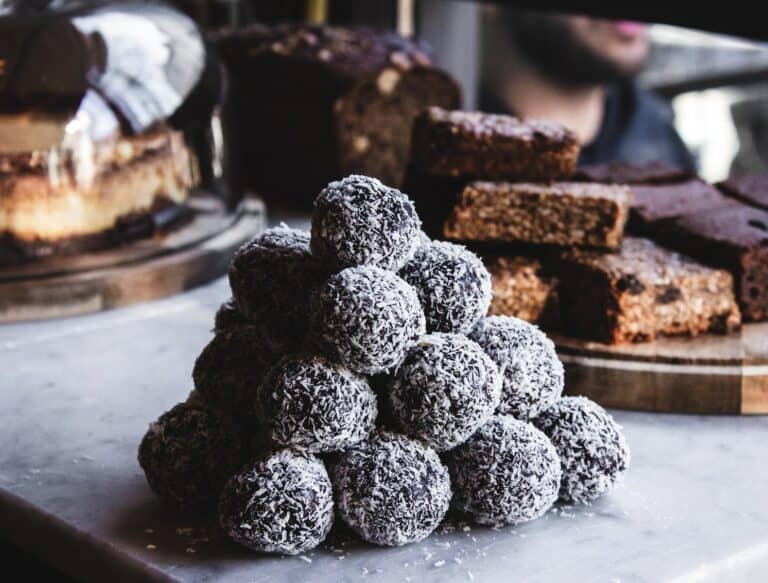If you’re like me, you probably think of chocolate as a sweet treat, perfect for a mid-afternoon pick-me-up or a bit of after-dinner indulgence. But guess what? Some culinary adventurers are turning this notion on its head, using chocolate in savory recipes.
Surprised? I was too. But it turns out that chocolate’s rich, smoky flavor can add a new dimension to a host of dishes, from chicken and pork to pasta and chili. It’s like adding a pinch of exotic spice that transforms the predictable into the piquant. So, if you’re feeling a bit daring in the kitchen, why not join these gourmets, gourmands, and foodies in their savory chocolate experiments?
Chocolate in Savory Recipes
Dark chocolate isn’t just for dessert anymore. Its rich and smoky flavor can add a new dimension to your favorite savory dishes. From chicken to chili, there’s a place for chocolate in your kitchen. I’ve found it to be a game-changer in my own cooking. It’s an unexpected ingredient that can truly elevate a dish.
Don’t be afraid to experiment. You might be surprised at how well chocolate blends with other flavors. It’s all about being adventurous and stepping outside of your comfort zone.

Dark chocolate, known for its power food status, can add a rich, smoky flavor to a variety of dishes. It’s about as commonplace as adding a pinch of salt or a dash of paprika in some countries. From chicken to pasta, chili, and even as a rub on beef, chocolate is making a grand appearance in the savory world.
So, if you’re feeling adventurous and ready to try something new, stay tuned. We’re about to explore the exciting world of savory chocolate recipes.
Exploring the Culinary Trend of Chocolate in Savory Recipes
Are you a brave and curious food lover? If you’re keen to indulge your taste buds and explore this new territory, savory chocolate recipes will surely astonish you. These aren’t your typical run-of-the-mill dishes; these are meals transformed, elevated, tinged with mystery. From everyday pasta to your Sunday chicken roast, think about drizzling a touch of choco goodness into your dishes.
If the term “savory chocolate recipe” is new to you, let me assure you: it’s not an innovation conjured from thin air. In many cultures, adding cocoa to savory dishes is as common as sprinkling salt or a dash of paprika. Ever tried a chicken dish with mole sauce? Then you’ve tasted the thrill of this mashup.
You might be wondering: what does dark chocolate or cocoa really bring to the savory table? Well, my friend, it’s all about the flavor. With its deep smoky notes, chocolate brings a layer of complexity and a unique twist that can transform commonplace flavors to a surprising culinary delight.
Remember, cooking is an adventure, a space for creativity, a realm where the predictable becomes the piquant. You could add a smidgen of chocolate to your pasta, sprinkle it in your chili, or even use it as an adventurous rub on beef. And as your dinner guests try to decipher the mysterious depth in your dishes, you’d be reveling in the secret of your flavor profile: chocolate.
Unique Ways to Incorporate Chocolate in Savory Cooking
Reimagining chocolate from dessert’s hero to a star ingredient in main courses can feel like a plunge into the unknown. But trust me, it’s a plunge worth taking. Let’s take inspiration from Mexican cuisine where chocolate adds a robust twist to classic dishes.
Dark Chocolate Chili stands out as a dramatic example. A two-bean chili recipe with a twist that caters to vegetarians and meat eaters alike. The chocolate’s depth and richness harmonize with the spicy, smoky chili, delivering an unforgettable flavor. It’s interesting to see how Mexican flavors influence the use of chocolate in savory dishes.

A daring combination taking the internet by storm involves roasted strawberries, savory cheese, crusty bread, and dark chocolate. This inventive sweet and savory treat guarantees an explosion of flavors, with the contrasting sharpness of the chocolate amplifying the other ingredients.
But don’t stop there. Chicken, pork, and pasta can all benefit from a bit of chocolate magic. Think smoky cocoa chicken, chocolate-infused pork roast, or a creamy cacao pasta. These might seem unusual, but the results are absolutely worth it. Experiencing how chocolate or cocoa injects a distinctive character into these dishes might just revolutionize the weekly family meals.
Then there’s innovative beef dishes like chocolate-rubbed beef chuck. This approach, using freshly ground black pepper and sea salt to taste, offers an enriched, melt-in-your-mouth experience. This is proof of chocolate’s versatility in savory cooking.
Evolving our taste perceptions and pushing culinary boundaries isn’t always comfortable. But it’s through experimentation that we discover unexpected delights and cultivate richer, more complex flavor profiles. Here’s to embracing the unpredictable and making the ordinary extraordinary with a little help from dark chocolate.
Chocolate as a Secret Ingredient in Main Courses
Chocolate is not strictly a dessert ingredient. I’ve found that when tastefully incorporated into savory main courses, the result can be nothing short of delectable. I’m not just talking about chili and pasta – there are a whole slew of savory dishes that can be taken to new heights with the addition of chocolate.
The trick lies in the amounts. By adding only a touch of chocolate, you bestow your dishes with a silky smooth texture and an added complexity. It’s a secret ingredient that never fails to make the dish stand out, without overwhelming the rest of the flavors.
My favorite example? Grilled sirloin. Amp it up with a smoky, chocolatey rub made from just five ingredients. Not only does it lend a rich, chocolaty hue, it also brings a smoked heat to the dish. It’s a simple twist that takes a standard meal to a gourmet level with minimum effort.
Let’s not confine ourselves to meat, though. Vegetarians, you’re not left out. Even the humble fig gets a flavor makeover when it’s stuffed with cream cheese, wrapped in bacon and spices, and touched by chocolate. The result? An irresistible concoction that dances between sweet and savory.
Finally, let’s not forget cocoa powder. It is a flexible and indispensable staple in most kitchens. Sprinkling some in stews can subtly enhance their depth and complexity.
What’s fantastic about chocolate is that it goes beyond convention. From (white) chocolate-spiked baba ghanouj to a beef and bean chili that boasts three different types of chocolate, these recipes shake up tradition and let you see chocolate from a fresh perspective. So next time you’re cooking, reach out for that bar of dark chocolate or that tin of cocoa powder. They might just be the magic touch your savory dish needs.
Elevating the Flavor Profile with Savory Chocolate Sauce and Dressings
Moving beyond the dessert scene, dark chocolate is brightening up the savory world, especially when it comes to sauces and dressings. It’s adding a sense of depth and remarkable layer of flavor to several meat dishes, transforming them into gourmet delights. Dark chocolate’s flavor depth, coupled with its subtle tartness, creates complex and velvety stews and sauces that are nothing short of perfection. It’s like a secret ingredient, covertly stepping your savory dishes up to the next notch.
Cocoa powder doesn’t fall far behind. It’s my all-time favorite go-to for a subtle, lingering chocolate essence that turns regular dishes into unforgettable culinary masterpieces. Think of adding a hint of it in your batters, your crusts, or perhaps, those BBQ rubs — trust me, it’s a culinary game changer. The key lies in subtlety; it’s the whisper of cocoa that leaves a lasting memory on the taste buds. For an added layer of depth, consider experimenting with some chocolate-themed BBQ rubs to elevate your grilling experience.
However, balance is a prerequisite. It’s important to remember that chocolate’s role in savory recipes is that of a balancing act rather than a lead performer. The trick lies in ensuring the chocolate does not overpower other ingredients. Rather, it should play a supporting part to enhance and uplift the complete ensemble of flavors. Artisanal vs. mass-produced chocolate plays a role here too; artisanal chocolate often carries nuanced flavors that can complement savory dishes more delicately.
If you’re one of those who’ve delighted in chocolate dishes like chocolate-infused mole sauce, you probably know what I’m talking about. Countries where adding chocolate to savory recipes is as commonplace as using salt or paprika might be onto something great. It’s all about that deep, smoky flavor chocolate brings that completely transforms a recipe, be it chicken, pork, or pasta — taking them from predictable to piquant. For inspiration, consider exploring the significance of cocoa rituals, which have long used chocolate in savory applications.
So go ahead and employ this secret weapon in your salads, meat dishes, and even your BBQs. Just remember to keep it as a subtle hint to sparkle curiosity among your family and friends — they’ll be vying to uncover the twist in the traditional. And who knows, you might find adding chocolate into your savory recipes as easy as a pinch of seasalt, literally.
Stay tuned to learn about some delicious savory chocolate recipes that’ll shake up your usual menu and breathe new life into your culinary adventures. And if you’re curious about how chocolate has made its way into other unexpected culinary realms, check out how chocolate is being used in fashion and other creative industries.
Sweet and Savory Combos: Desserts with a Twist
When it comes to cooking, we often think of chocolate as an ingredient destined solely for sweet treats. Sure, it’s a staple in traditional desserts like mousses, brownies, and cakes.
But, what if we told you there’s another equally tempting arena where chocolate is a star player? Yes, savory dishes! The unique blend of chocolate’s sweetness, acidity, and bitterness creates a perfect palette for flavor balancing and depth in savory foods.
Let’s consider this dreamy recipe involving squash and chocolate. It’s a classic savory dish that impresses with a twist. The combination of squash and the subtle complexity brought on by chocolate gives this dish a distinctive fall vibe. Moreover, with cocoa powder or cacao nibs subbing for sugar-filled chocolate, you’ll end up with a savory sensation that tantalizes taste buds without overpowering them.

Moving a bit south, we find a Mexican culinary secret: pairing chocolate with chili. Whether you’re a meat lover or a vegetarian, this versatile recipe engulfs your palate with a surprising yet delightful, spicy-sweet combo. A quintessential Mexican flavor, chocolate adds a rich depth to chili’s fiery zest.
And let’s not forget the sweet tooth among us. Chef’s special – roasted strawberries served with a savory-meets-sweet sandwich. The recipe layers cocoa butter, sweet strawberries, savory cheese, crispy bread, and bittersweet dark chocolate to create a quick yet refined treat. It’s a simple preparation that brings a gourmet twist to your regular meal, charming you with its impressive flavor profile.
For those daring cooks out there, remember: trying to incorporate chocolate into savory dishes brings an exciting adventure. Boldly experiment and enjoy the journey of transforming a simple dish into one offering an unexpected richness with chocolate’s silkiness and complexity.
Frequently Asked Questions
1. How can dark chocolate be used in savory recipes?
Dark chocolate can add a rich and smoky flavor to various savory dishes. This includes chicken, pork, pasta, and chili, where chocolate’s unique flavor enhances the overall taste and texture of the meal.
2. Apart from desserts, how else can chocolate be used in cooking?
Chocolate, especially dark variants, is not just for sweets and desserts. Its strong, savory side brilliantly shines through in sauces, chili, meats and even vegetable and pasta dishes. It adds a depth of flavor that can transform a dish from ordinary to extraordinary.
3. What role does chocolate play in baking?
Chocolate plays a significant role in baking, providing structure and absorbing moisture. Baked goods made with chocolate require more water and whole eggs than those without cocoa products. Furthermore, chocolate’s fat content lends a distinct texture to the dessert.
4. Can I use any type of chocolate for cooking?
While baking chocolate is usually recommended, you can use normal eating chocolate as a substitute in recipes. Just bear in mind that ground chocolate has added sugar, so you might need to adjust the amount of sugar in your recipe accordingly.
5. What are the health implications of consuming chocolate daily?
Eating too much chocolate may lead to health problems, such as weight gain, tooth decay, heightened risk of heart disease, and type 2 diabetes. Moreover, the caffeine content in chocolate could potentially impact your sleep patterns.
